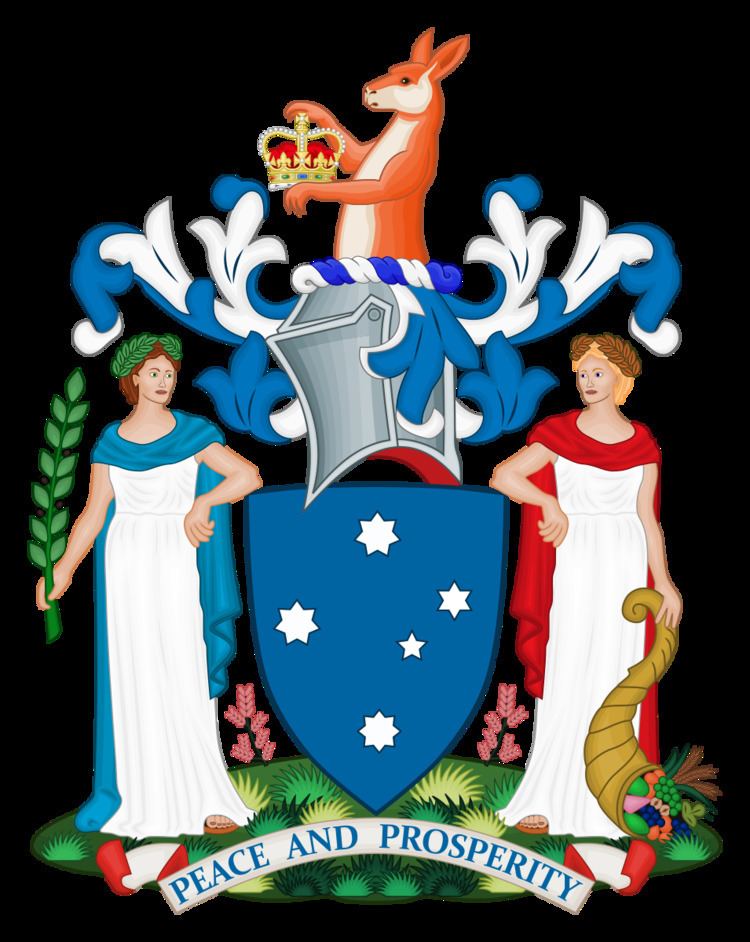Founded 1851 | ||
 | ||
President Bruce Atkinson, LiberalSince 21 December 2010 Leader of the Council Gavin Jennings, LaborSince 23 December 2014 Leader of the Opposition Mary Wooldridge, LiberalSince 17 December 2014 | ||
The Victorian Legislative Council (VLC) is the upper house of the bicameral Parliament of Victoria, Australia; the lower house being the Legislative Assembly. Both houses sit at Parliament House in Spring Street, Melbourne. The Legislative Council serves as a house of review, in a similar fashion to its federal counterpart, the Australian Senate. Although it is possible for legislation to be first introduced in the Council, most bills receive their first hearing in the Legislative Assembly.
Contents
- First Legislative Council
- Second Legislative Council
- Composition
- Current distribution of seats
- References
The presiding officer of the council is the President of the Legislative Council. The council presently has 40 members serving four-year terms, elected from eight electoral regions each with five members.
First Legislative Council
The separate colony of Victoria was proclaimed on 1 July 1851 and writs for the election of the first Legislative Council were issued at the same time. It took some time before the Council was elected and ready to sit. The Legislative Council initially consisted of 30 members, 10 members being nominated by the Lieutenant-Governor and 20 members elected from 16 "electoral districts", with Melbourne electing 3 members, and Geelong and the county of Bourke electing 2 members each. The electors were male British subjects over the age of 21 years, who owned freehold valued at £100 or a householder paying rent of £10 per year, both very large sums at the time. Members of the Legislative Council were unpaid, further restricting participation of those without independent means. The Legislative Council met for the first time in November 1851 at St Patrick's Hall, which had been built in 1847 in Bourke Street, Melbourne. The Legislative Council sat there until the opening of the Parliament House in 1856.
The Legislative Council was expanded in 1853 to 18 nominees and 36 elected members. A further expansion of the Council occurred in 1855, when 8 new members were elected from five new electorates, with one new nominee.
The first Legislative Council served Victoria for five years and was responsible for at least three significant and enduring contributions to the parliamentary system of Victoria:
The new constitution was approved by the Legislative Council in March 1854. It was sent to Britain where it was passed by the United Kingdom Parliament as the Victoria Constitution Act 1855, received Royal Assent on 16 July 1855 and was proclaimed in Victoria on 23 November 1855. The Constitution established a Westminster-style system of responsible government that continues in Victoria today.
Second Legislative Council
The new Constitution came into effect in 1856. It created a bicameral Parliament of Victoria, with the Legislative Assembly being the lower house and the Council being the upper house. The Council consisted of 30 members, with 5 members being elected from each of the 6 provinces. The Parliament of Victoria first met on 21 November 1856 at the almost completed main sections of Parliament House.
The Legislative Council was later elected from a varying number of provinces. In 1882 several new provinces were created with Central and Eastern being abolished. In 1904 more provinces were created and members of the council sat for two assembly terms so two members (MLCs) represented each province, elected in rotation one at a time by majority-preferential (AV) vote.
Until 1950 the Legislative Council was elected on a restricted property-based franchise and always had a conservative majority.
Prior to the 2006 election, the Legislative Council consisted of 44 members elected for eight-year terms from 22 two-member electorates. This old system tended to favour the Liberal Party and the National Party (often in Coalition) over the Australian Labor Party and other parties. This caused many instances where a Labor-controlled Assembly faced an opposition-controlled Council — a rare occurrence elsewhere in Australia.
The system changed for the 2006 Victorian election, as a result of major reforms passed by the Labor government, led by Steve Bracks, in 2003. Under the new system the State is divided into eight regions each of which elect five members, who serve fixed four-year terms unless the Assembly is dissolved sooner. Each region consists of 11 contiguous Legislative Assembly districts with about 420,000 electors. Five regions are urban (Eastern Metropolitan Region, Northern Metropolitan Region, South Eastern Metropolitan Region, Southern Metropolitan Region, and Western Metropolitan Region) and three are non-urban (Eastern Victoria Region, Northern Victoria Region and Western Victoria Region). Since 2006 members have been elected using the single transferable vote system of proportional representation. The opportunity was also taken to remove the Council's ability to block supply. The reforms have made it easier for minor parties to gain election to the chamber and possibly gain the balance of power, as opposed to majority control by a single major party.
Composition
Today the Council has 40 members serving four-year terms, elected from 8 electoral regions, with 5 members representing each region.
Current distribution of seats
The state of the parties in the Council as a result of the 2014 Victorian state election is as follows:
